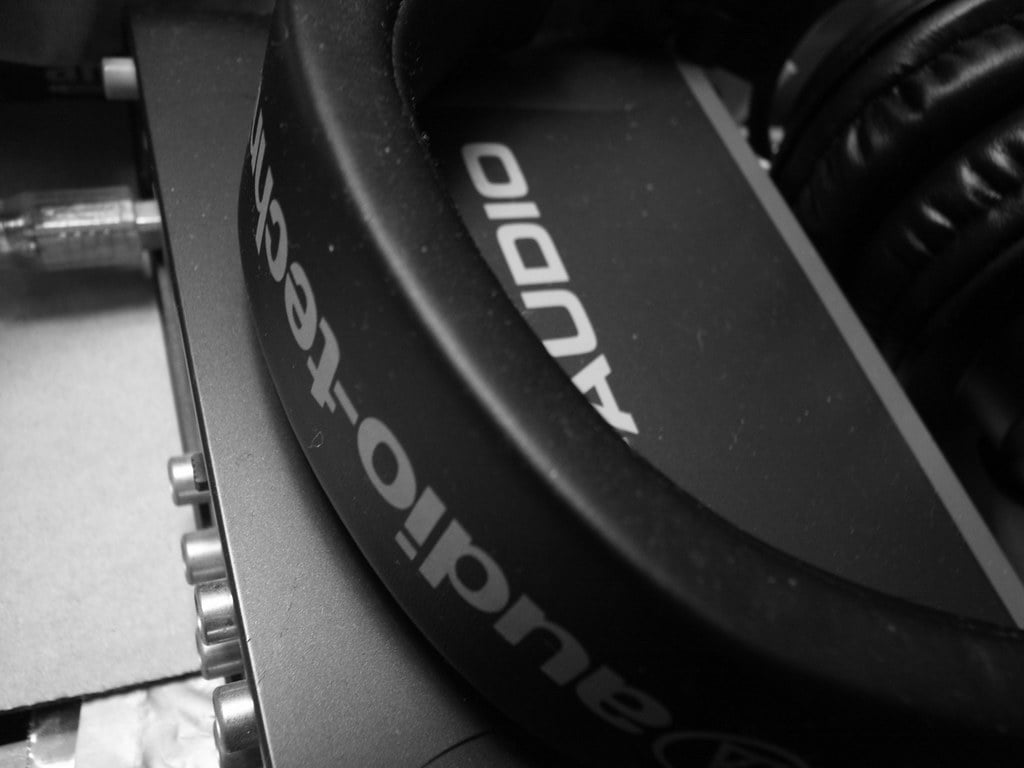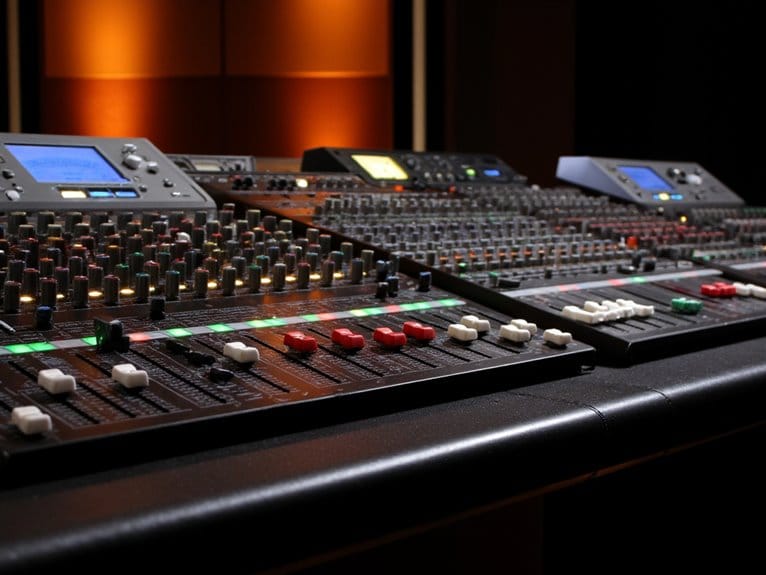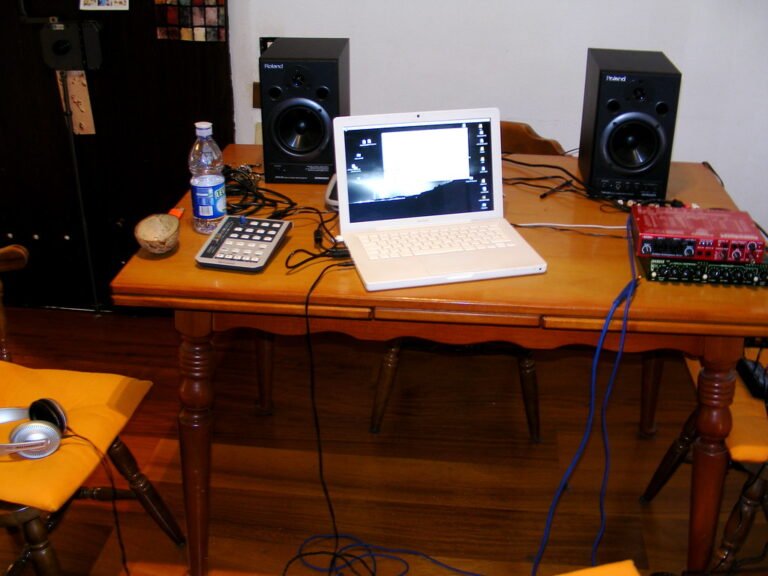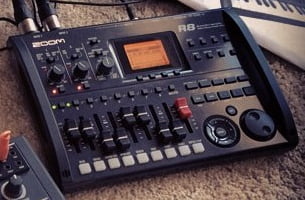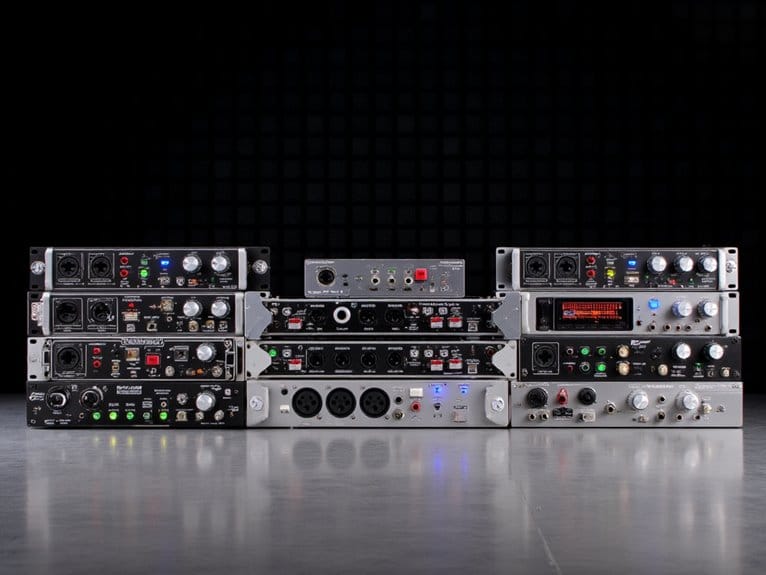Audio Interface Preamps: What You Need to Know for Quality Recordings
Understanding the essential role of preamps in audio interfaces is key to achieving high-quality recordings. Preamps boost microphone signals to line level, amplify weak signals, and guarantee incoming audio is strong enough for quality results. External preamps offer clean gain, maintain tonal balance, and capture a full spectrum of sound accurately, making them crucial for sensitive microphones. By bypassing internal preamps in audio interfaces, adding coloration, texture, and greater control to recordings becomes possible. Input impedance variations play a significant role in preserving original audio quality, underscoring the importance of proper impedance matching. Seeking community advice on preamp choices can provide valuable insights for informed selections that elevate recording quality.
We are supported by our audience. When you purchase through links on our site, we may earn an affiliate commission, at no extra cost for you. Learn more.
Importance of Preamps in Audio Interfaces
Boosting microphone signals to line level, preamps in audio interfaces play an essential role in ensuring accurate and high-quality recordings. A preamp, short for preamplifier, is a critical component in the audio chain that amplifies weak microphone signals to a level suitable for recording. In the analog domain, these signals need to be brought up to line level for best processing and storage. The preamp in an audio interface is responsible for this task, ensuring that the incoming audio is strong enough to be captured faithfully.
When it comes to recording sound, the quality of the preamp directly affects the overall recording quality. A high-quality preamp can capture the nuances and subtleties of a sound source without introducing unwanted noise or distortion. This is particularly important when working with delicate acoustic instruments or capturing vocals with a wide dynamic range. External preamps, apart from offering additional features and controls, can also impart a unique sonic character to recordings, giving them a distinct coloration.
Enhancing Sound Quality With Preamps
When considering sound quality in recordings, the utilization of external preamps proves pivotal in delivering enhanced audio fidelity and distinctive tonal characteristics. External preamps offer clean gain, which is essential for boosting the signal from microphones without introducing noise or distortion. This clean gain guarantees that the original audio signal is amplified accurately, preserving its integrity throughout the recording process.
In audio recording, a good preamp is indispensable for maintaining tonal balance and capturing the full spectrum of sound accurately. Different preamps have varying frequency responses and coloration, allowing for tailored sound shaping to achieve the desired sonic characteristics. When working with sensitive microphones, such as condenser mics, having a high-quality external preamp becomes even more vital. These microphones require sufficient gain and a low noise floor to capture subtle details effectively.
Furthermore, external preamps play a significant role in signal amplification, ensuring that even the quietest sounds are adequately captured without compromising the overall audio quality. By understanding how preamps impact tonal balance and signal amplification, audio professionals can make informed decisions to achieve professional-level recordings with depth and clarity. Investing in quality external preamps can elevate the sound quality of recordings by providing a transparent and detailed audio capture that surpasses the limitations of built-in interface preamps.
Upgrading to External Preamps
Upgrading to external preamps introduces a new sonic dimension to audio recordings by bypassing internal preamps in audio interfaces. External preamps offer a range of benefits that can greatly enhance the quality and versatility of your recordings:
- Enhanced Sonic Character: External preamps can add coloration and texture to your recordings, providing a unique sonic signature that differs from internal preamps.
- Improved Frequency Response: Upgrading to external preamps can result in a more accurate and extended frequency response, capturing a wider range of audio nuances.
- Unique Sound Characteristics: Different types of external preamps have distinct sonic qualities, allowing you to choose a preamp that best complements your recording style and preferences.
- Greater Control and Flexibility: External preamps offer more control over the preamplification process, enabling finer audio adjustments to tailor the sound to your specific requirements.
Impact of Input Impedance Variations
Input impedance variations play an important role in shaping the interaction between microphones and preamps, directly impacting signal transfer and fidelity in audio recordings. Matching the input impedance of a microphone to that of a preamp is essential for optimizing signal transfer. An impedance mismatch between the microphone and preamp can result in signal loss, altered frequency response, and potential distortion in the recorded audio.
To guarantee peak performance and sound quality, it is vital to understand and adjust the input impedance settings on the preamp. Different microphones may require specific input impedance settings to achieve the best recording results. By paying close attention to input impedance matching, audio engineers can prevent signal degradation and maintain fidelity throughout the recording process.
When input impedance is properly matched, the signal transfer between the microphone and preamp is maximized, preserving the original audio quality. This attention to detail in impedance settings contributes significantly to the overall clarity and accuracy of the recorded sound. As a result, adjusting input impedance to achieve the ideal match between microphones and preamps is a critical step in producing high-quality audio recordings.
Seeking Community Advice for Preamp Choices
The Gearspace community offers invaluable insights for making informed preamp selections to enhance recording quality. When seeking community advice for preamp choices, consider the following:
- User Experiences: Explore user experiences shared on Gearspace to grasp the real impact of preamp choices on sound quality. These firsthand accounts can provide valuable insights into the practical applications of different preamps.
- Community Engagement: Engage with the Gearspace community to investigate a wide range of preamp options tailored to your specific recording needs. By tapping into the collective knowledge of fellow audio enthusiasts, you can discover hidden gems that align with your requirements.
- VIP Guest Q&A Sessions: Attend VIP guest Q&A sessions on Gearspace to learn about the latest preamp features and functionalities. These sessions often go deep into technical aspects, helping you understand how different preamps can elevate your recordings.
- Exclusive Discussions: Participate in exclusive discussions on Gearspace to gather insights that can guide you towards making informative decisions when selecting preamps for your audio interface. These discussions may uncover lesser-known brands or models that perfectly suit your recording setup.

